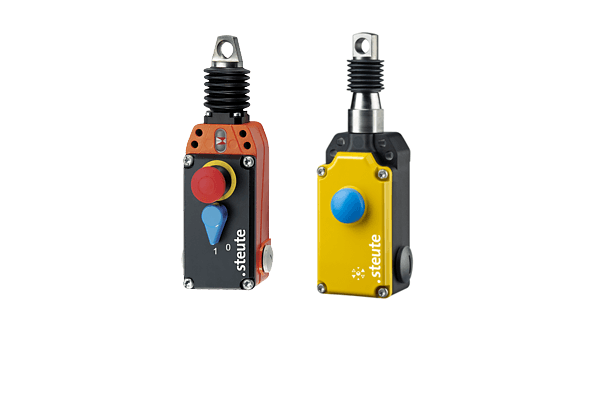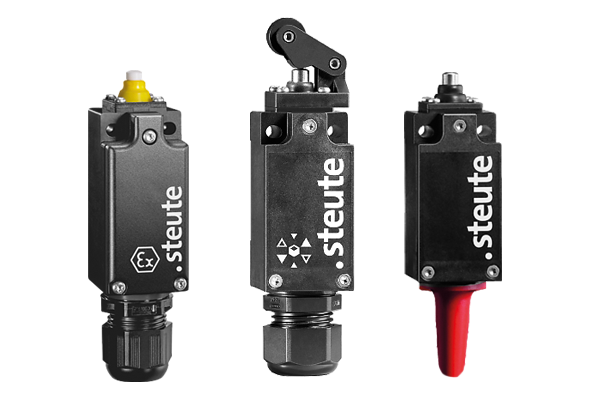Safety switches
A safety switch allows you to monitor the position of a safety device (safety doors, gates and hatches). As soon as the door is opened, the safety switch gives a signal to the safety controller or control unit. The control immediately stops a machine function or dangerous movement. Manipulation of the safety device must be excluded. For example, the safety sensor can ensure that the safety device cannot be opened until the dangerous production process has been stopped. As soon as the safety device is closed, the safety switch ensures that the production process is resumed. ReeR Safety and steute are specialists in switchgear, each with its own unique properties.
There are many different types of safety switches:
- Safety switch with pull cord
- Safety switch with foot control
- Safety switch with interlock
- Safety switch for position determination
- Non-contact safety switches


Safety switch with pull cord
Pull-wire switches are safety switches equipped with a pull-cord. The pull-on / activation of the pull cord is detected by the mechanical contacts and the switch is operated. By using forced contacts (fail safe), the pull cord switch can be used as a safety component.
- Plastic and metal housing
- ATEX version (2D / 2G)
- Protection degree: IP54 to IP69K
- Single and double-sided operation
- Temperature: -60 ° C to + 180 ° C
Safety switch with foot control
Foot-operated safety switches are also known as foot switches or foot pedals. Foot switches are used in industry and machine construction to switch parts on or off, where manual operation is not practical or possible. Additional safeguards are available for accidental operation of the foot switch.
Features of foot operated safety switches:
- Plastic and metal housing
- ATEX version (2D / 2G)
- Degree of protection: IP65 and IP67
- 1 or 2 operating pedals with or without protective cover
- Wireless variants
- Temperature: -25 ° C to + 80 ° C


Safety switch with lock - Solenoid interlock
Safety interlock switches are also known as safety interlocks, solenoid interlocks or electromagnetic door interlocks. Unlike classic safety switches, safety interlocks have an additional lock.
Features safety switch with lock:
- Plastic and metal housing
- 100% mechanical interlock system
- ATEX version (2D / 2G / 3D / 3G)
- Protection degree: IP64 to IP67
- Temperature: -20 ° C to + 90 ° C
Safety switch for position determination
Position safety switches are also known as position switches and limit switches. The safety switches guard and monitor the position of valves, valves and hatches, for example, and confirm the presence of an object.
- Plastic and metal housing
- ATEX version (2D / 2G / 3D)
- Degree of protection: IP65 to IP69K
- Analog switching output
- Wireless variants
- Temperature: -40 ° C to + 180 ° C


Non-contact safety switches
Non-contact safety switches are ideal for applications where precise guidance of the shielding is difficult and are the solution for moving safety devices such as doors, flaps, fences or shields. Non-contact safety switches are coded in different versions.
- Electronically coded non-contact safety switch
- Non-contact magnetically coded safety switch
- RFID coded non-contact safety switch
Hinge switch for rotatable safety devices
A hinge safety switch is suitable for rotating safety devices that must be closed to guarantee the required safety. Depending on the version, hinge switches can protect installation and maintenance-friendly doors, as well as heavy doors in machine and system construction. The EEx 335 V.S hinge switch from steute can be used in extreme environmental conditions.
Characteristics EEX 335 safety device:
- Explosion zone 1 & 21
- Metal housing
- Drive shaft can be rotated 360 °
- Special version for dust explosion zone 22
